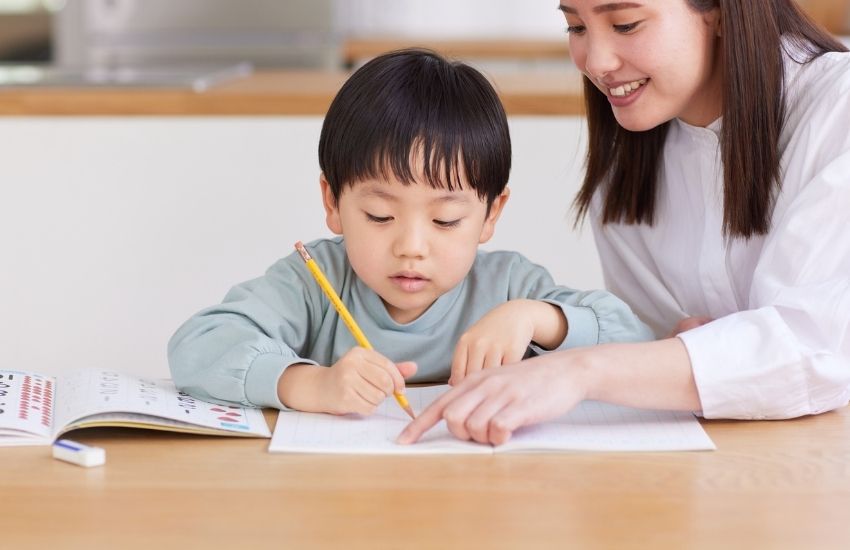Learning to write letters doesn’t have to boring. In fact, some of the best ways to support your child’s handwriting development are hands-on, playful, and full of movement! By using multisensory activities, children not only have fun but also develop their fine motor skills, coordination, and motor planning needed for clear and confident handwriting.
Here are some fun and creative ways to practice letter formation at home:
Shaving Cream Writing
Spread some shaving cream on a tray, tabletop, shower screen or even a window, and let your child write letters with their finger. For early writers, you can also write the letter first, for them to trace over with their finger, before having a go themselves. It’s a sensory-rich, messy play activity that helps with letter formation. You can also use a paintbrush or cotton bud for kiddos that would prefer not to touch the shaving cream with their fingers.

Rainbow Writing
Ask your child to write the same letter several times using different coloured crayons or markers. Each colour traces over the last, creating a rainbow effect. It’s visually fun and helps reinforce the correct shape and strokes of each letter. Put a green ‘go’ down for where to start and include an arrow to help them remember the correct letter strokes to write the letter with correct letter formation.

Sensory Trays
Fill a tray with salt, sand, or flour and have your child use their finger (or a paintbrush or cotton bud) to trace letters.

Playdough Letter Mats
Roll out “snakes” of playdough and shape them into letters using laminated templates or printed letter cards. This helps build hand strength and coordination—both essential for handwriting success. Trace over the letters with your finger, a pencil or paintbrush to practice the letter strokes for correct formation. To help with knowing where to start, poke your finger to make a dot in the playdough.

Giant Letters on the Floor
Use painter’s tape to create large letter outlines on the floor. Then encourage your child to walk, hop, jump, or drive a toy car along the lines of each letter. This combines gross motor play with letter recognition!
Water Writing
Hand your child a paintbrush and a cup of water and let them “paint” letters onto a chalkboard, driveway, or fence. It’s mess-free and magical as the water disappears—plus, it's great for practicing correct letter strokes.
Add extra practice, by first writing it with water, then tracing over the water writing with chalk.

Highlighter Letters
This is a great way for kids to practice pencil control (controlling pencil to stay within the coloured guidelines), but also supports kids in understanding when writing a letter, what the end product will look like.
Add a starting dot, for where kids should start the letter, and directional arrows to support them in understanding how to start and stroke directions. A nice way to support reluctant or early writers, and great for practicing writing name.



Alphabet Target Practice
Write letters on paper plates and spread them around the room or yard. Call out a letter sound and have your child throw a beanbag or soft ball at the correct one. After hitting the target, they can practice writing that letter on the paper plate too. This adds movement and excitement to handwriting practice!
Why Sensory-Based Handwriting Activities Work – And What Comes Next
These activities are fun—but they’re also grounded in evidence-based practice. Research supports that multisensory and play-based learning can help children develop the foundational motor, sensory, and perceptual skills required for successful handwriting.
However, while sensory and movement-based activities are fantastic for engagement and skill development, they’re most effective when followed by actual handwriting practice – what OTs sometimes refer to as task specific practice.
To support progress, we recommend following these steps:
1. Start with a sensory-based warm-up activity (e.g. playdough, floor letters, or shaving cream writing).
2. Transition into focused handwriting tasks on paper— practicing the letter you have focused on in the sensory activity, and writing this with correct formation on paper. This could be writing a single sound that is modelled for them by an adult, or writing this from memory. Then writing this sound into a word.
3. Keep handwriting practice short and positive, using fun materials like whiteboards, coloured pens, or themed worksheets to keep your child motivated.
How Inner West Paediatrics Can Help
At Inner West Paediatrics, our Occupational Therapists use evidence-based frameworks to support children in building the skills needed for everyday life.
We work collaboratively with families and educators to create individualised therapy plans that support success both at home and in the classroom. If your child is struggling with handwriting, avoiding writing tasks, or showing signs of frustration, we’re here to help with assessments, therapy, and practical strategies you can use every day.
Get in touch with us to learn more or book an appointment.
Disclaimer
All information provided is general and not intended to substitute professional advice. Inner West Paediatrics can consult with you to support your child’s individual needs.



